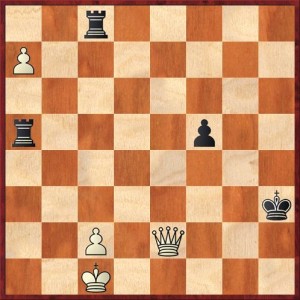Today Gjon Feinstein and I were going over a wonderful game between Wei Yi and John Bryant from the recent Bay Area International, a game that I’m planning to lecture on for ChessLecture. There’s one variation that I wasn’t quite sure how to evaluate, and as often happens we ended up playing about twenty moves past the critical point. At that point it’s really just fantasy chess, having nothing to do with the real game.
Nevertheless, fantasy chess is… fantastic sometimes. Take a look at this position.
FEN: 2r5/P7/8/r4p2/8/7k/2P1Q3/2K5 w – – 0 1
First let me say that this would not be very good as a composed study, because White in fact has several winning moves. So what I’m really looking for here is a winning concept. Can you see what it is?
I’m proud of the fact that it took me only about a minute, maybe two minutes tops, to hit on the right idea. The first thing you have to realize is that direct checks will get you nowhere. Black has just happened on a unique piece configuration where I can never fork his rooks. The f5 pawn does a particularly awesome job, preventing all the potential checks along the c8-h3 diagonal, and I can’t get rid of the f5 pawn because it’s defended by the rook on a5. Amazingly, there seems to be no way for White to make progress.
Do you see the right concept yet? If not, ask yourself, “What would Black do if it were his move?” Hmm… If the king moves, Qe1+ will fork the king and rook. If the pawn moves, Qe6+ will fork the king and the other rook. If the rook on a5 moves horizontally, it will lose its grip on the queening square, a8. If it moves vertically, the pawn on f5 will be undefended and it will fall after Qf3+. Then the rook on c8 loses its shelter, and things look bad for Black. Finally, if the rook on c8 moves, it will again lose the pawn shelter and become a target for forking threats.
Conclusion: Black has no good moves. He is in zugzwang!
Therefore, I triumphantly played 1. Kb2!! Note that Black doesn’t even have any good checks, and the king takes away several squares on the a-file.
You can check for yourself that 1. Kb2 wins in every single line. There are lots of lines that go down to Q+P versus R+P, but these are all easily won for White, as the Nalimov tablebases confirm. I think that the trickiest line is (1. Kb2) Rg8, when the computer gives 2. Qf1+ Kh2 3. Qf4+! Kh3 4. Qc7! This simultaneously threatens two forks, on c3 and h7. Black can get out of them both by playing a check, 4. … Rb5+ 5. Kc1 Ra8, but now 6. Qc6 forks the two rooks!
When I came home and put the position on Rybka, I was gratified to see that 1. Kb2! was its top choice… for about half a second. Then it started liking 1. Qe6 better. And I agree, that’s a somewhat more direct way to win. Basically, White just had to realize that any move that forces Black to disrupt the delicate configuration of his two rooks and pawn is a winning move. As soon as White realizes this and stops playing checks, he wins.
Nevertheless, I still like the subtlety of 1. Kb2. What a great and unexpected winning move!



